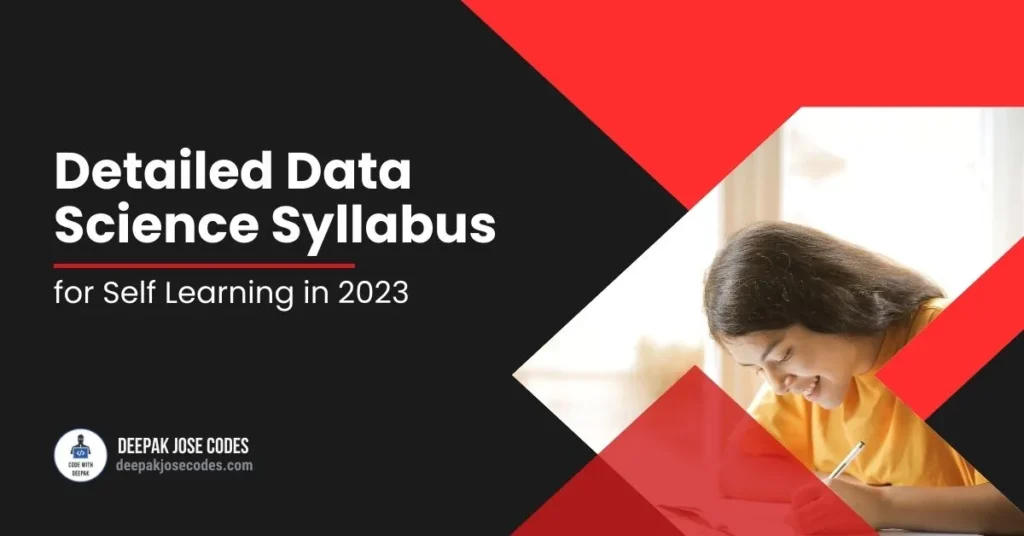Data Science is an interdisciplinary field that extracts insights and information from data using techniques from statistics, computer science, and domain experience. If you want to go on a self-learning journey in Data Science, this complete Data Science Syllabus will walk you through each step of the process.
Let’s get started

Contents
- Step 1: Building a Solid Foundation
- Resources
- Step 2: Data Acquisition and Preprocessing
- Resources
- Step 3: Proficient Exploratory Data Analysis (EDA)
- Resources
- Step 4: Fundamentals of Machine Learning
- Resources
- Step 5: Immersive Exploration of Advanced Topics
- Resources
- Step 6: Showcasing Skills with a Capstone Project
- Resources
- Conclusion
Step 1: Building a Solid Foundation
1.1 Mastering Mathematics and Statistics
- Fundamentals of Linear Algebra: Learn about vectors, matrices, and their operations. Understand concepts such as eigenvectors and eigenvalues, which are critical for comprehending machine learning algorithms.
- Calculus Expertise: Expand your knowledge of differentiation, integration, and optimization’s. Recognize their significance in machine learning models and training processes.
- Probability and Statistics: Gain a strong understanding of probability theory, which is necessary for dealing with uncertainty in data. For robust analysis, investigate statistical distributions, hypothesis testing, and confidence intervals.
1.2 Mastering Programming and Tools
- Python Essentials: Learn how to program in Python. Discover the fundamentals of data structures, control flow, and object-oriented programming. Develop your ability to manipulate data efficiently.
- Git Version Control: Learn the art of version control with Git. Learn how to easily build repositories, track changes, and interact with others.
Resources
- Linear Algebra:
- Book: “Introduction to Linear Algebra” by Gilbert Strang
- Khan Academy Linear Algebra Course: Link
- Calculus:
- Book: “Calculus” by James Stewart
- Khan Academy Calculus Course: Link
- Probability and Statistics:
- Book: “Introduction to Probability” by Joseph K. Blitzstein and Jessica Hwang
- Coursera Course: “Probability and Statistics” by Stanford University: Link
- Python Essentials:
- Version Control with Git:
Step 2: Data Acquisition and Preprocessing
2.1 Effective Data Collection
- Web Scraping Techniques: Learn about web scraping using libraries such as Beautiful Soup and Scrapy. Collect information from websites, news portals, and other online sources.
- API Integration: Discover how to use Python to connect with APIs. Data can be retrieved from a variety of sources, including Twitter, Reddit, and weather services.
- Database Administration: Learn SQL to query relational databases. Learn how to successfully retrieve and manipulate data.
2.2 Data Cleaning and Preprocessing Strategies
- Handling Missing Data: Learn how to deal with missing data, from imputation to advanced techniques such as K-Nearest Neighbours imputation.
- Data Transformation Techniques: Explore data scaling, normalization, and dimensionality reduction techniques such as Principal Component Analysis (PCA).
- Addressing Outliers: Learn about outlier detection strategies and their implications for analysis. Implement effective solutions for dealing with outliers.
Resources
- Web Scraping Techniques:
- API Integration:
- Database Management:
- Handling Missing Data:
- Data Transformation Techniques:
- Addressing Outliers:
- Article: “Dealing with Outliers – A Must in Machine Learning” by Analytics Vidhya: Link
Step 3: Proficient Exploratory Data Analysis (EDA)
3.1 Data Visualization Mastery
- Matplotlib and Seaborn: Use these Python packages to master the art of creating various forms of visualizations. To successfully explain ideas, customize charts.
- Interactive Visualization: Plotly provides dynamic and interactive visualizations, making your presentations more engaging and insightful.
- Take a look at using Tableau/PowerBI For Data Analysis and Visualization. Its Used Commonly By Data Analysts
3.2 Descriptive and Inferential Statistics
- Summary Statistics: Learn descriptive statistics such as mean, median, and mode. Understand the implications of variability measures.
- Correlation and Covariance: Discover how to compute correlation and covariance coefficients. Create a visual representation of correlations to find relationships between variables.
- Hypothesis Testing and Confidence Intervals: Expand your understanding of hypothesis testing topics such as p-values and confidence intervals. Learn how to derive valid inferences from your data.
Resources
- Matplotlib and Seaborn:
- Interactive Visualization:
- Summary Statistics:
- Correlation and Covariance:
- Hypothesis Testing and Confidence Intervals:
Step 4: Fundamentals of Machine Learning
4.1 Mastery in Supervised Learning
- Linear Regression: Learn more about linear regression. Understand its assumptions, metrics for evaluation, and expansions such as polynomial regression.
- Classification Algorithms: Discover logistic regression and the theory that underpins it. Learn more about k-Nearest Neighbours and its uses.
4.2 Unsupervised Learning Techniques
- Clustering Algorithms: Examine K-Means and Hierarchical Clustering in depth. Understand their distinctions, applications, and evaluation methods.
- Dimensionality Reduction: For feature reduction and visualisation, use Master Principal Component Analysis (PCA) and t-Distributed Stochastic Neighbour Embedding (t-SNE).
4.3 Advanced Model Evaluation and Selection
- Cross-Validation Methods: Use k-Fold and stratified cross-validation to achieve accurate model performance evaluation.
- Mastery of Evaluation Metrics: Understand the significance of precision, recall, F1-score, ROC curves, and AUC in evaluating classification models.
4.4 Model Refinement and Deployment
- Hyperparameter Tuning: Learn how to fine-tune models using grid search and random search approaches. Improve overall performance and generalisation.
- Model Deployment: Investigate model serialisation with Pickle. Using Flask, create RESTful APIs for model deployment.
Resources
- Linear Regression:
- Classification Algorithms:
- Clustering Algorithms:
- Dimensionality Reduction:
- Cross-Validation Techniques:
- Evaluation Metrics Mastery:
- Hyperparameter Tuning:
- Model Deployment:
Step 5: Immersive Exploration of Advanced Topics
5.1 Unlocking Natural Language Processing (NLP)
- Text Preprocessing Techniques: For effective text analysis, master tokenization, stemming, and stop-word elimination.
- Sentiment Analysis: Learn how to do sentiment analysis using techniques such as Bag of Words, TF-IDF, and pre-trained word embeddings.
5.2 Time Series Analysis and Forecasting
- Understanding Time Series Components: Learn about time series components such as trend, seasonality, and noise. Discover decomposition techniques.
- Forecasting Techniques: Learn more about the ARIMA and LSTM models. With confidence, forecast and foretell.
5.3 Journey into Deep Learning
- Neural Network Architectures: Understand the basics of neural networks. Discover the differences between feedforward, convolutional, and recurrent neural networks.
- Convolutional Neural Networks (CNNs): Investigate CNN designs for image classification, object identification, and image segmentation.
- Recurrent Neural Networks (RNNs): Learn about RNNs and how they may be used for sequence data processing, language modelling, and time series prediction.
5.4 Addressing Ethical Considerations
- Data Ethics: Recognise the ethical implications of data collecting and use. Learn about data privacy, security, and ethical AI practises.
- Algorithmic Bias and Fairness: Investigate how bias affects model outcomes and ways for mitigating it.
Resources
- Text Preprocessing Techniques:
- Sentiment Analysis:
- Time Series Components:
- Forecasting Techniques:
- Neural Network Architectures:
- Convolutional Neural Networks (CNNs):
- Recurrent Neural Networks (RNNs):
- Ethical Data Usage:
- Algorithmic Bias and Fairness:
Step 6: Showcasing Skills with a Capstone Project
- Determine a Problem: Choose a real-world problem or dataset that is relevant to your interests.
- Data Collection and Analysis: Use your learnt skills to successfully collect, clean, analyze, and visualize data.
- Create a thorough report: Summarize your findings, observations, and recommendations. Demonstrate your expertise and actual application.
Resources
- Kaggle Datasets: Kaggle offers a vast collection of datasets across various domains. Explore Kaggle’s datasets: Link
- UCI Machine Learning Repository: UCI hosts a wide range of datasets for machine learning projects.: Link
- Open Data Portals: data.gov provides datasets from the US government: Link
- Google Dataset Search: Google’s Dataset Search is a useful tool to discover datasets across the web: Link
Conclusion
Embracing the field of Data Science requires devotion, but with this self-learning syllabus at your disposal, your path is set. You’ll be able to thrive in the dynamic Data Science landscape if you grasp fundamental ideas, conquer advanced areas, and participate in actual projects. You’re not simply learning Data Science; you’re becoming a driving force of innovation in the ever-changing world of data through continual learning and hands-on experience.
For More Data Science Related Posts and Resources Check out: https://deepakjosecodes.com/category/data-science/
Comment down your thoughts and suggestions for future posts


send me updates in mail